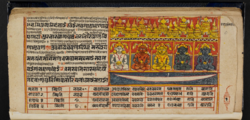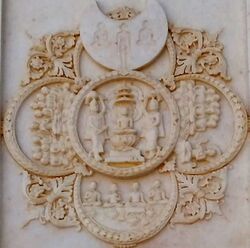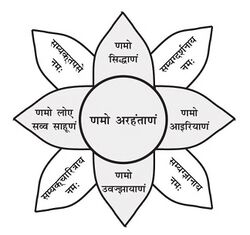Religion:Pañca-Parameṣṭhi
From HandWiki
Short description: Hierarchy of religious authorities
The Pañca-Parameṣṭhi , read as Pancha Parmeshthee (Sanskrit: पञ्च परमेष्ठी for "five supreme beings") in Jainism are a fivefold hierarchy of religious authorities worthy of veneration.[1][2]
Overview
The five supreme beings are:
- Arihant: The awakened souls who have attained keval gyan are considered as Arihant. The 24 Tirthankaraas or Jinas, the legendary founding figures of Jainism in the present time cycle are Arihants. All Tirthankaras are Arihants but not all Arihants are Thirthankars.[2]
- Siddha (Ashiri): The souls which have been liberated from the birth and death cycle.
- Acarya
- Upadhyaya ("Preceptors")
- Muni or Jain monks
The five initials, viz. A+A+A+U+M are taken as forming the Aum syllable.[1]
Five supreme beings
Dravyasaṃgraha, a major Jain text, succinctly characterizes the five Supreme Beings (Pañca-Parameṣṭhi).[3]
- Definition of the World Teacher (Arhat) - verse 50.[4]
- Definition of the liberated souls (Siddha) - verses 51.[5]
- Definition of the Chief Preceptor (Acarya) - verse 52.
- Definition of the Preceptor (Upadhyaya) - verse 53.
- Definition of the Ascetic (Sadhu) - verse 54.
| “ | Meditate on, recite or chant the sacred mantras, consisting of thirty-five, sixteen, six, five, four, two and one letter(s), pronouncing the virtues of the five supreme beings (Pañca-Parameṣṭhi). Besides, meditate on and chant other mantras as per the teachings of the Preceptor (guru).[6] | ” |
Arihant
Having destroyed the four inimical varieties of karmas (ghātiyā karmas), possessed of infinite faith, happiness, knowledge and power, and housed in most auspicious body (paramaudārika śarīra), that pure soul of the World Teacher (Arhat) should be meditated on.—Dravyasaṃgraha (50)[4]
See also
- Namokar Mantra
- Paramita
- Jainism
Notes
- ↑ 1.0 1.1 Jaini, Padmanabh S. (1998). The Jaina Path Of Purification. Motilal Banarsidass. p. 163. ISBN 9788120815780. https://books.google.com/books?id=wE6v6ahxHi8C&q=kalyanaka+bhumi&pg=PA343. Retrieved 10 December 2012.
- ↑ 2.0 2.1 Shah, Natubhai (1998). Jainism: The World of Conquerors, Volume 1. Sussex Academic Press. p. 174. ISBN 9781898723301. https://books.google.com/books?id=EmVzvUzbwegC&q=jain+rituals&pg=PA169. Retrieved 14 December 2012.
- ↑ Jain 2013, p. 177-196.
- ↑ 4.0 4.1 Jain 2013, p. 177.
- ↑ Jain 2013, p. 182.
- ↑ Jain 2013, p. 173.
References
- Johnson, Helen M. (1931), The 108 Qualities of the Pañcaparameṣṭhins (Appendix 1.5 of the Trishashti Shalaka Purusha Caritra), Baroda Oriental Institute, https://www.wisdomlib.org/jainism/book/trishashti-shalaka-purusha-caritra/d/doc212568.html
- Jain, Vijay K. (2013), Ācārya Nemichandra's Dravyasaṃgraha, Vikalp Printers, ISBN 9788190363952, https://books.google.com/books?id=g9CJ3jZpcqYC, "Non-copyright"
 |




